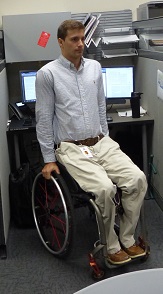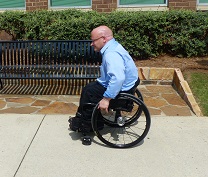By Allison Tubbs, CHES, ACSM-EPC, Project Coordinator, National Center on Health, Physical Activity and Disability
Welcome to the start of a New Year with new hopes, wishes, and strategies on the roadmap! Does your 2018 roadmap ensure that everyone is able to benefit from and enjoy your health promotion efforts? One in five adults in the United States have some type of disability, and approximately one in eight working-age adults have a disability. It’s everyone’s job to build inclusive workplaces and provide equal opportunities for worksite wellness.
Having a disability does not equate to being unhealthy, but individuals with disabilities experience higher rates of obesity, chronic diseases, and secondary health conditions due to health inequities. All people have the right to access their community and lead active, healthy lifestyles. This starts with an investment in inclusive health and creating inclusion in our work spaces and places. For most, the workplace is where a majority of one’s waking hours are spent and provides an optimal setting to add in short bursts of physical activity to improve productivity and general health status while reducing health care costs and absenteeism.
Make it happen with these three ways to burn up to 100 calories in the workplace! The following are exercises, resources, and a sample routine that can be used to create tailored 100-calorie workouts to incorporate into your worksite wellness programming.

First, there are several seated exercises to help increase one’s physical activity level in the workplace. One example is an adaptation of arm dips or an isometric hold, a strength-building exercise often seen in fitness facilities. Using a wheelchair or office chair to perform this activity makes this a great exercise to do while at work or any other time of the day. Chair dips or wheelchair push-ups can be performed by placing hands on handles, armrests or wheels and pushing oneself up and off a seat cushion. When doing these, be sure any wheelchair breaks are on or transfer to an office chair with arms. Make sure to do this exercise on a flat surface with no obstacles nearby. Performing this exercise for a total of five minutes, broken up into 60 second increments per day on average can help burn up to 100 extra calories per week! As a bonus, wheelchair push-ups or chair dips can also help with other life activities, such as transferring out of a wheelchair, carrying groceries or other bags, and preventing pressure sores.
Second, many activities can be performed at a desk. Below, we provide an example of a five-minute, desk-based interval training routine. Each exercise should be performed for one full minute, followed by one minute of rest before moving on to the next exercise, for a total of five minutes. Doing this five-minute routine twice every workday can help burn up to 100 extra calories per week and provide 10 minutes of movement.
- Desk Push-Ups – Moving to the edge of a secure seat and slightly leaning forward, use the edge of a secure table or desk to move the chest back and forth in a push-up motion.
- Arm Circles – Find or create enough room to extend arms out fully to the sides to do arm circles. These can be big and small circles, rotating forward and backward, and other variations and methods to maintain movement for a full minute.
- Arm Punches – Ensure room for a full range of arm motion, punching forwards, sideways, or up in the air.


Lastly, walking is beneficial for our overall health and wellness and also provides low-impact movement that can easily be incorporated into the workday. Just 10 minutes of wheelchair walking per day can burn up to 40 calories. If safe and accessible routes are available, encourage outdoor walking for employees to enjoy fresh air for an additional benefit. Walking breaks can also be a great time for co-workers to converse or to have a moving meeting in replacement of a sedentary one.
As you kick off your health promotions for the year, consider actively planning for and including employees with disabilities. Use this infographic to encourage employees to burn 100 calories at work. An investment in inclusion is one that will provide full circle benefits for all! 
Consider the following resources for tips to make your investment happen:
- Burn 100 Calories at Your Workplace
- Workplace Wellness Exercises for Individuals Who Use Wheelchairs
- Disability Inclusion
- Disability Inclusion Works for All
- 9 Guidelines for Disability Inclusion
- Get Moving Towards Inclusive Worksite Wellness
Spread the Word! Share this post with your networks using this sample tweet: It’s everyone’s job to build inclusive workforces and invest in wellness. Learn tips from @NCHPAD to make it happen in the BAWY blog! http://bit.ly/2DYEs0d #WorksiteWellness #CommitToInclusion